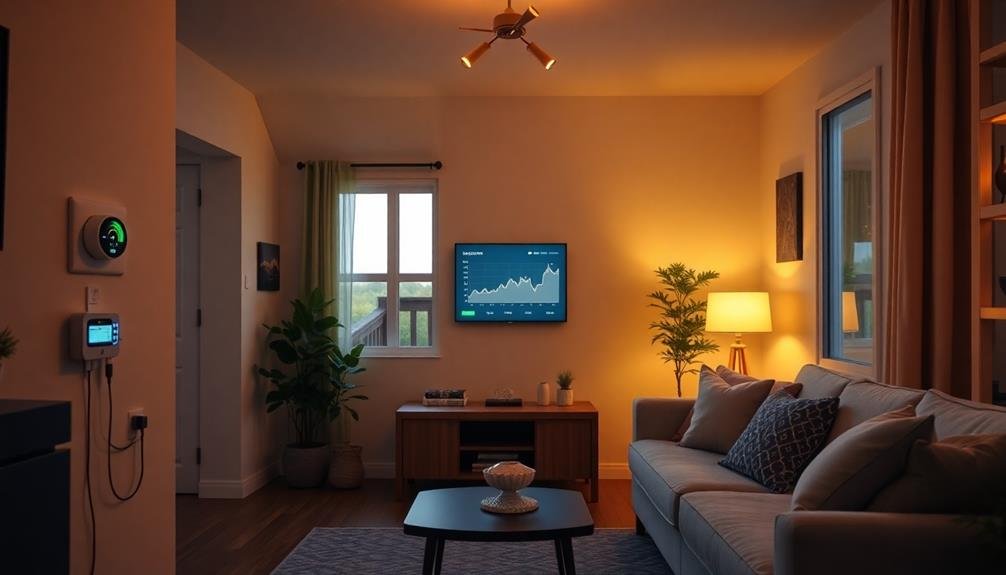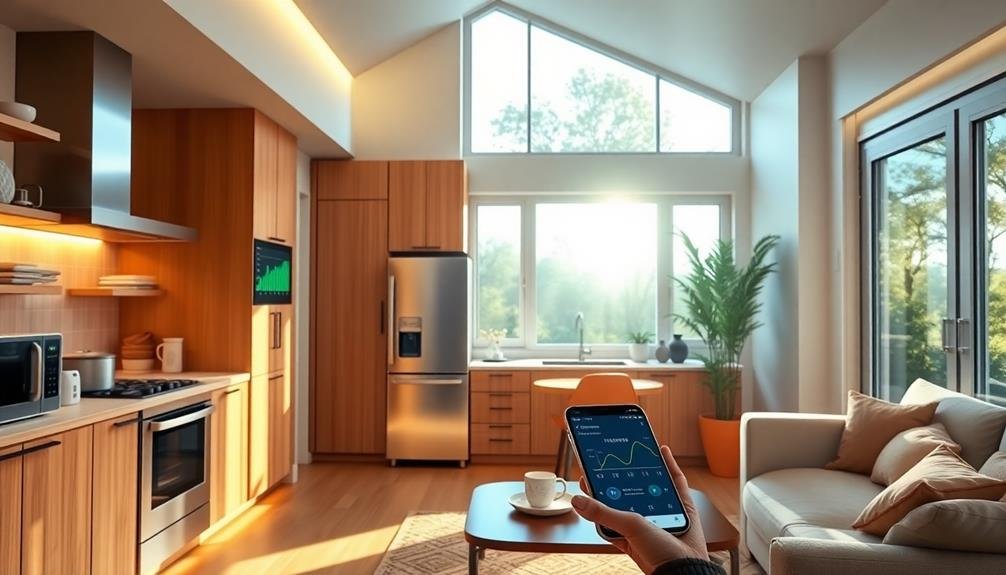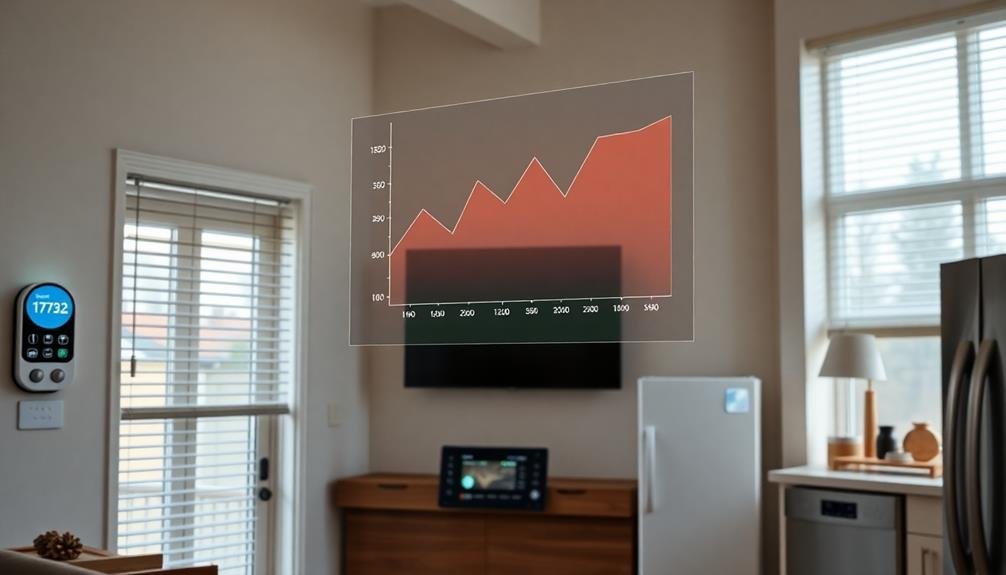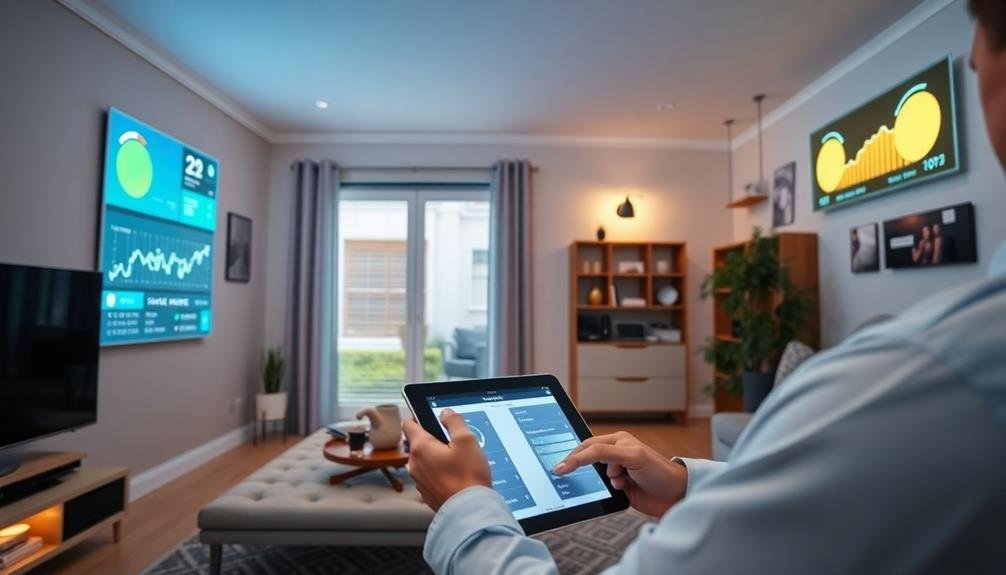You'll slash your energy bills and boost your home's efficiency by implementing automated energy tracking and conservation strategies. Smart meters provide real-time data on consumption, while home energy management systems integrate smart devices for thorough monitoring and control. IoT devices offer granular insights into power usage, enabling data-driven decisions. Automated appliance control and smart scheduling optimize energy use during off-peak hours. Solar integration with battery storage reduces grid reliance, and machine learning algorithms personalize efficiency recommendations. Smart thermostats and energy-efficient appliances further cut costs. By embracing these technologies, you'll access significant savings and a greener home. Discover how to maximize your energy-saving potential.
Smart Meters and Energy Monitoring
With the advent of smart technology, home energy tracking has become more accessible and precise than ever before. Smart meters are at the forefront of this revolution, providing real-time data on your energy consumption. These devices replace traditional electricity meters, communicating directly with your utility company and eliminating the need for manual readings.
You'll find that smart meters offer a wealth of information at your fingertips. They'll show you exactly how much energy you're using at different times of the day, allowing you to identify peak usage periods and adjust your habits accordingly. Many smart meters come with companion apps or online portals where you can view detailed breakdowns of your energy consumption.
Energy monitoring systems take this a step further. They can track individual appliances and circuits, giving you granular insights into which devices are consuming the most power.
You'll be able to spot energy hogs and make informed decisions about upgrades or replacements. Some systems even offer predictive analysis, alerting you to potential issues before they lead to significant energy waste or costly breakdowns.
Home Energy Management Systems
Home Energy Management Systems (HEMS) take your energy tracking to the next level by integrating smart devices throughout your home.
You'll be able to monitor and control appliances, lighting, and HVAC systems in real-time, optimizing your energy usage.
With HEMS, you can easily identify energy-hungry devices and make informed decisions to reduce consumption and lower your utility bills.
Smart Device Integration
Smart device integration forms the backbone of modern home energy management systems. By connecting various smart appliances and devices to your central energy management hub, you'll gain unprecedented control over your home's energy consumption. You can monitor and adjust the power usage of individual devices remotely, allowing for more efficient energy allocation throughout your home.
Smart thermostats, lighting systems, and appliances can communicate with each other and your energy management system. This interconnectedness enables automated adjustments based on your preferences, occupancy, and real-time energy pricing. For example, your system can automatically dim lights when natural light is sufficient or adjust your HVAC settings when you're away.
To integrate smart devices, you'll need a compatible hub or platform that can communicate with various protocols like Wi-Fi, Zigbee, or Z-Wave. Many energy management systems offer smartphone apps, allowing you to control and monitor your home's energy use from anywhere.
As you add more smart devices to your network, you'll create a more thorough and efficient energy ecosystem, leading to significant savings on your utility bills and a reduced carbon footprint.
Real-Time Energy Monitoring
Transparency in energy consumption is the key benefit of real-time energy monitoring systems. These systems provide you with up-to-the-minute data on your home's energy usage, allowing you to make informed decisions about your power consumption.
You'll see exactly how much electricity each appliance and device is using, enabling you to identify energy hogs and adjust your habits accordingly.
Real-time monitoring empowers you to take control of your energy usage like never before. You'll experience:
- Shock at discovering which appliances are secretly draining your wallet
- Pride in watching your energy consumption decrease as you make smarter choices
- Excitement when you spot opportunities to save money on your utility bills
- Satisfaction in knowing you're reducing your carbon footprint
With this information at your fingertips, you can make immediate changes to reduce your energy consumption.
You'll be able to turn off unnecessary devices, adjust thermostat settings, and optimize your energy usage patterns.
Real-time monitoring also helps you verify the effectiveness of energy-saving measures you've implemented, ensuring you're getting the most bang for your buck when it comes to energy efficiency upgrades.
IoT Devices for Power Tracking

Many homeowners are turning to Internet of Things (IoT) devices to track their power consumption. These smart gadgets connect to your home's electrical system and provide detailed insights into your energy usage.
You'll find a variety of options, from simple plug-in monitors to whole-house systems that integrate with your electrical panel.
Smart plugs are an easy entry point. You can plug them into any outlet and connect your appliances to monitor individual device consumption. For a more extensive approach, consider smart power strips that track multiple devices simultaneously. Whole-house energy monitors offer the most detailed data by connecting directly to your breaker box.
Many IoT energy devices come with user-friendly mobile apps. You'll receive real-time updates on your power usage, allowing you to identify energy hogs and adjust your habits accordingly.
Some advanced systems even use machine learning to predict your future energy needs and suggest optimizations.
When choosing an IoT power tracking device, look for features like:
- Easy installation and setup
- Compatibility with your existing smart home ecosystem
- Clear, actionable data visualization
- Alerts for unusual energy spikes
- Integration with renewable energy sources, if applicable
Data Analytics and Consumption Patterns
Three key components drive the power of data analytics in home energy tracking: collection, analysis, and interpretation. As you gather data from your IoT devices, you're building a detailed picture of your home's energy usage. This information becomes the foundation for identifying patterns and trends in your consumption habits.
By analyzing this data, you'll uncover insights about when and how you use energy most. You might discover that your HVAC system runs more than necessary during certain hours or that your dishwasher consumes an unexpected amount of power. These revelations empower you to make informed decisions about your energy usage.
Interpreting the data allows you to take action. You can adjust your habits, upgrade appliances, or implement automation to reduce waste. The emotional impact of this knowledge can be profound:
- Shock at discovering hidden energy drains
- Excitement about potential savings opportunities
- Pride in taking control of your energy consumption
- Satisfaction in reducing your environmental impact
As you continue to track and analyze your energy data, you'll develop a deeper understanding of your home's unique energy profile. This knowledge becomes a powerful tool for ongoing optimization and conservation efforts.
Automated Appliance Control Strategies

Automated appliance control strategies can greatly reduce your energy consumption and costs.
You'll benefit from smart scheduling that optimizes appliance usage during off-peak hours and remote control capabilities that allow you to manage devices from anywhere.
These systems also provide real-time monitoring, enabling you to track energy usage patterns and make informed decisions about your home's energy efficiency.
Smart Scheduling for Savings
Smart scheduling is a game-changer for homeowners looking to maximize energy savings. By utilizing smart home technology and energy management systems, you can automate when your appliances and devices operate, ensuring they run during off-peak hours when electricity rates are lower.
This strategic approach not only reduces your energy bills but also helps balance the load on the power grid.
To implement smart scheduling effectively, consider these key strategies:
- Program your thermostat to adjust temperatures based on your daily routine, ensuring comfort while minimizing energy waste.
- Set your dishwasher, washing machine, and dryer to run during late-night hours when energy demand is lowest.
- Use smart plugs to automatically power down non-essential devices during peak hours or when you're away from home.
- Schedule your electric vehicle to charge overnight, taking advantage of cheaper rates and reducing strain on the grid during high-demand periods.
Remote Control and Monitoring
Building on the concept of smart scheduling, remote control and monitoring take your home energy management to the next level. You'll have the power to control and observe your home's energy consumption from anywhere, using your smartphone or tablet. This capability allows you to make real-time adjustments, ensuring ideal energy efficiency even when you're away.
With remote control, you can:
- Turn off forgotten appliances
- Adjust thermostat settings
- Dim or turn off lights
- Activate or deactivate security systems
Monitoring provides insights into your home's energy usage patterns, helping you identify areas for improvement. You'll receive alerts for unusual consumption spikes or malfunctioning appliances.
Here's a comparison of popular remote control and monitoring systems:
| System | Remote Control | Energy Monitoring | Smart Home Integration | Mobile App | Price Range |
|---|---|---|---|---|---|
| Nest | Yes | Yes | Extensive | iOS/Android | $$$ |
| Ecobee | Yes | Yes | Good | iOS/Android | $$ |
| Sense | No | Detailed | Limited | iOS/Android | $$ |
| Wemo | Yes | Basic | Good | iOS/Android | $ |
| Hive | Yes | Yes | Growing | iOS/Android | $$ |
Real-Time Energy Use Notifications
While monitoring your home's energy consumption is valuable, real-time energy use notifications take this awareness to the next level.
These alerts provide instant feedback on your energy consumption, allowing you to make immediate adjustments to reduce waste and lower your bills. You'll receive push notifications on your smartphone or smart home display when energy usage spikes or exceeds predefined thresholds.
Real-time notifications offer several benefits that can evoke powerful emotions:
- Empowerment: You'll feel in control of your energy usage, making informed decisions to reduce consumption.
- Satisfaction: Watching your energy usage decrease in real-time provides a sense of accomplishment.
- Relief: Identifying and addressing energy waste quickly can alleviate concerns about high utility bills.
- Excitement: Gamifying energy conservation through notifications can make saving power fun and engaging.
To set up real-time notifications, configure your smart meter or energy monitoring system to send alerts based on your preferences.
You can customize thresholds for different appliances or overall home consumption. By acting on these notifications promptly, you'll develop energy-efficient habits and see significant savings on your utility bills over time.
Solar Integration and Battery Storage

Integrating solar power and battery storage can take your home energy tracking to new heights. With these systems in place, you'll gain more control over your energy production and consumption. Solar panels allow you to generate clean electricity, while batteries store excess energy for later use.
Your energy tracking system becomes more sophisticated when you add solar and storage. You'll be able to monitor real-time solar production, battery charge levels, and grid consumption. This all-encompassing view helps you optimize energy use and reduce reliance on the grid.
Many modern energy tracking platforms offer specific features for solar and battery integration. You can set up alerts for peak solar production times, encouraging you to run energy-intensive appliances when your panels are generating the most power.
You'll also be able to track how much energy you're storing and using from your batteries, helping you maximize self-consumption.
With solar and battery integration, you can even participate in demand response programs or sell excess energy back to the grid. Your energy tracking system becomes a powerful tool for managing your home's energy ecosystem, potentially leading to significant cost savings and a reduced carbon footprint.
Machine Learning in Energy Optimization
Machine learning algorithms are revolutionizing home energy enhancement. These intelligent systems analyze your energy consumption patterns, weather data, and appliance usage to create personalized energy-saving strategies.
By implementing machine learning in your home energy tracking system, you'll gain insights that can greatly reduce your power bills and environmental impact.
These algorithms can predict your energy needs, automatically adjusting your home's temperature, lighting, and appliance usage for ideal efficiency. They'll learn your preferences over time, ensuring comfort while minimizing waste.
You'll also receive tailored recommendations for energy-saving upgrades and behavior changes based on your specific usage patterns.
To fully appreciate the impact of machine learning on energy optimization, consider these emotional benefits:
- Peace of mind knowing your home is always operating at peak efficiency
- Pride in actively reducing your carbon footprint
- Excitement about embracing cutting-edge technology to improve your daily life
- Satisfaction from seeing tangible savings on your energy bills
Energy-Saving Automation Scenarios

Smart homes' energy-saving automation scenarios offer practical ways to reduce consumption without sacrificing comfort. You can set up your home to automatically adjust heating, cooling, lighting, and appliance usage based on occupancy, time of day, or weather conditions.
For example, you might program your thermostat to lower temperatures when you're asleep or away, and raise them just before you return home. Smart plugs can power down electronics during off-hours, eliminating standby energy waste. Motion sensors can turn lights on and off as you move through your home, ensuring you're only using energy where needed.
Consider these popular energy-saving automation scenarios:
| Scenario | Action | Potential Savings |
|---|---|---|
| Night mode | Dim lights, lower temp | 10-15% on HVAC |
| Away mode | Turn off non-essentials | 5-10% overall |
| Solar optimization | Run appliances during peak sun | 20-30% on electricity |
| Smart water heating | Heat water only when needed | 10-20% on water heating |
| Adaptive lighting | Adjust based on natural light | 25-35% on lighting |
Cost Reduction Through Smart Technologies
You can greatly reduce your energy costs by implementing smart technologies in your home.
Smart thermostats learn your preferences and automatically adjust temperature settings, leading to substantial savings on heating and cooling bills.
Upgrading to energy-efficient appliances, such as ENERGY STAR certified models, can further cut your electricity consumption and lower your monthly expenses.
Smart Thermostats Save Money
A simple yet effective way to reduce energy costs is by installing a smart thermostat in your home.
These devices learn your temperature preferences and daily routines, automatically adjusting your home's climate for ideal comfort and efficiency. You'll save money by reducing unnecessary heating and cooling when you're away or asleep.
Smart thermostats offer remote control via smartphone apps, allowing you to adjust settings from anywhere. They also provide detailed energy reports, helping you understand your usage patterns and identify areas for improvement.
Many models integrate with other smart home devices, creating a more thorough energy management system.
To maximize your savings with a smart thermostat:
- Program realistic temperature setpoints for different times of day
- Take advantage of eco-friendly modes when you're away
- Use the device's learning capabilities to fine-tune your schedule
- Regularly review energy reports and adjust your habits accordingly
Energy-Efficient Appliance Upgrades
While smart thermostats offer considerable energy savings, upgrading to energy-efficient appliances can further reduce your home's power consumption. Modern appliances with ENERGY STAR certification use 10-50% less energy than their older counterparts, leading to substantial cost savings over time.
When replacing your appliances, consider these energy-efficient options:
| Appliance | Energy-Efficient Features | Potential Savings |
|---|---|---|
| Refrigerator | Improved insulation, LED lighting | Up to 15% on cooling costs |
| Washing Machine | High-efficiency motors, cold water cycles | 25% less energy, 33% less water |
| Dishwasher | Soil sensors, improved water filtration | 12% less energy, 30% less water |
| HVAC System | Variable-speed motors, smart controls | Up to 20% on heating/cooling |
You'll see the biggest impact by replacing older, high-energy-consuming appliances first. For example, swapping out a 15-year-old refrigerator for a new ENERGY STAR model can save you up to $50 annually on electricity bills. Don't forget about smaller appliances like LED light bulbs, which use 75% less energy than incandescent bulbs and last 25 times longer. By strategically upgrading your appliances, you'll reduce your energy consumption and lower your utility bills considerably.
Frequently Asked Questions
How Secure Are Home Energy Tracking Systems Against Cyber Threats?
You'll find that home energy tracking systems vary in security. While reputable brands often have robust protections, they're not immune to cyber threats. It's essential you choose a system with strong encryption and regularly update its software.
Can Energy Tracking Systems Work With Older, Non-Smart Home Appliances?
Yes, you can use energy tracking systems with older appliances. You'll need to install smart plugs or sensors to monitor their power consumption. These devices connect to your tracking system, allowing you to measure and analyze energy use efficiently.
What's the Typical Return on Investment Timeframe for Home Energy Management Systems?
You'll typically see a return on investment for home energy management systems within 2-5 years. Your savings will depend on your energy usage, local utility rates, and the system's effectiveness in reducing consumption.
Are There Privacy Concerns With Sharing Energy Consumption Data With Utility Companies?
Yes, there are privacy concerns. When you share energy consumption data, you're revealing personal habits and routines. Utility companies could potentially misuse this information. However, regulations often protect your data, and you can opt-out of certain sharing programs.
How Do Energy Tracking Systems Account for Varying Electricity Rates During Peak Hours?
Your energy tracking system can monitor real-time electricity rates and adjust usage accordingly. It'll track consumption during peak and off-peak hours, allowing you to optimize your energy use and save money on your utility bills.
In Summary
You've got the power to take control of your home's energy use. By embracing smart meters, IoT devices, and automation, you'll gain insights into your consumption patterns and optimize your usage. Don't forget to integrate solar and battery storage for even greater savings. With machine learning and data analytics, you're set to reduce costs and conserve power effortlessly. It's time to make your home smarter and more energy-efficient – start tracking and automating today!





Leave a Reply